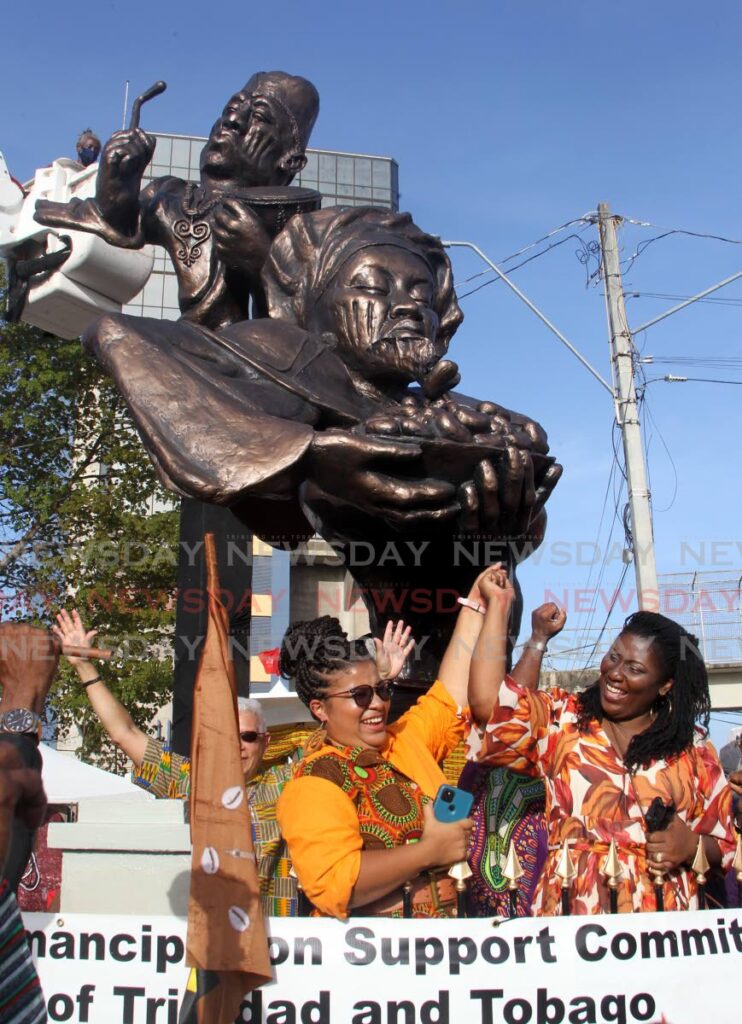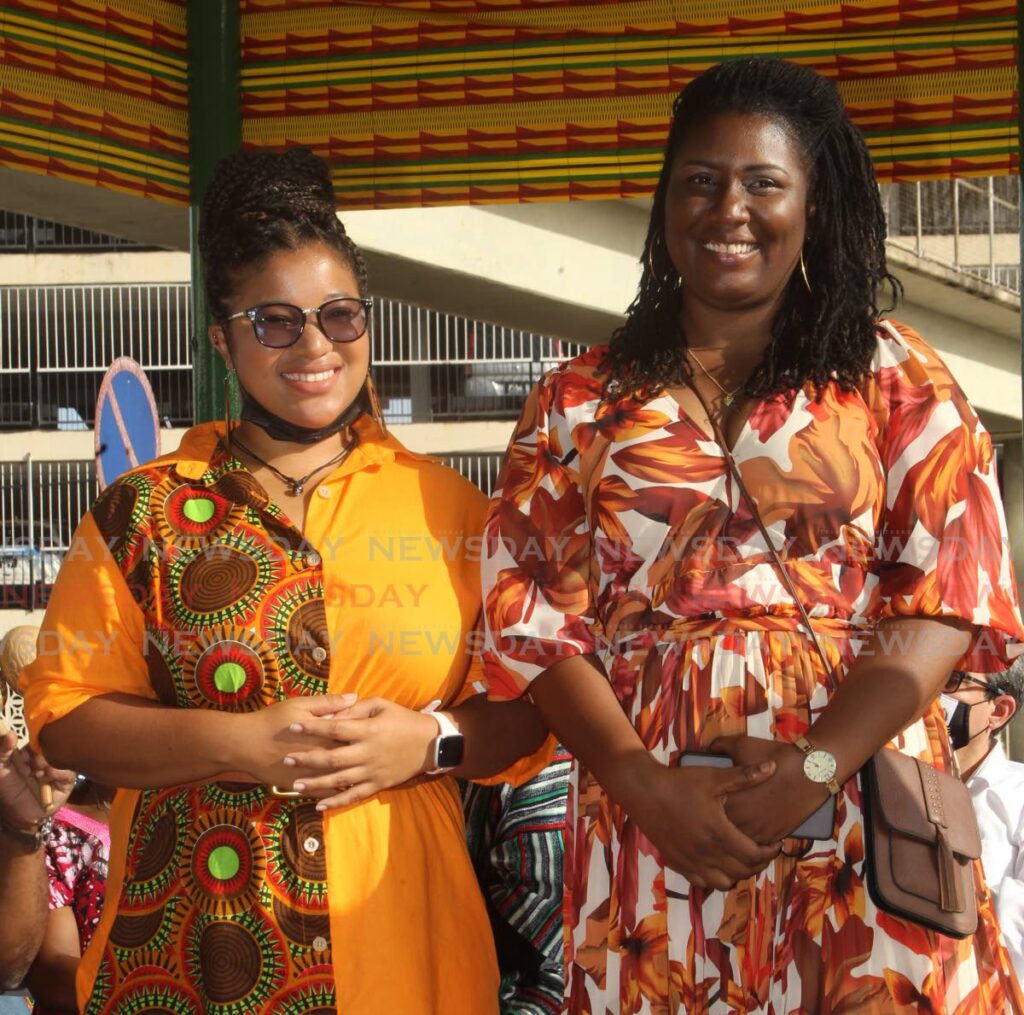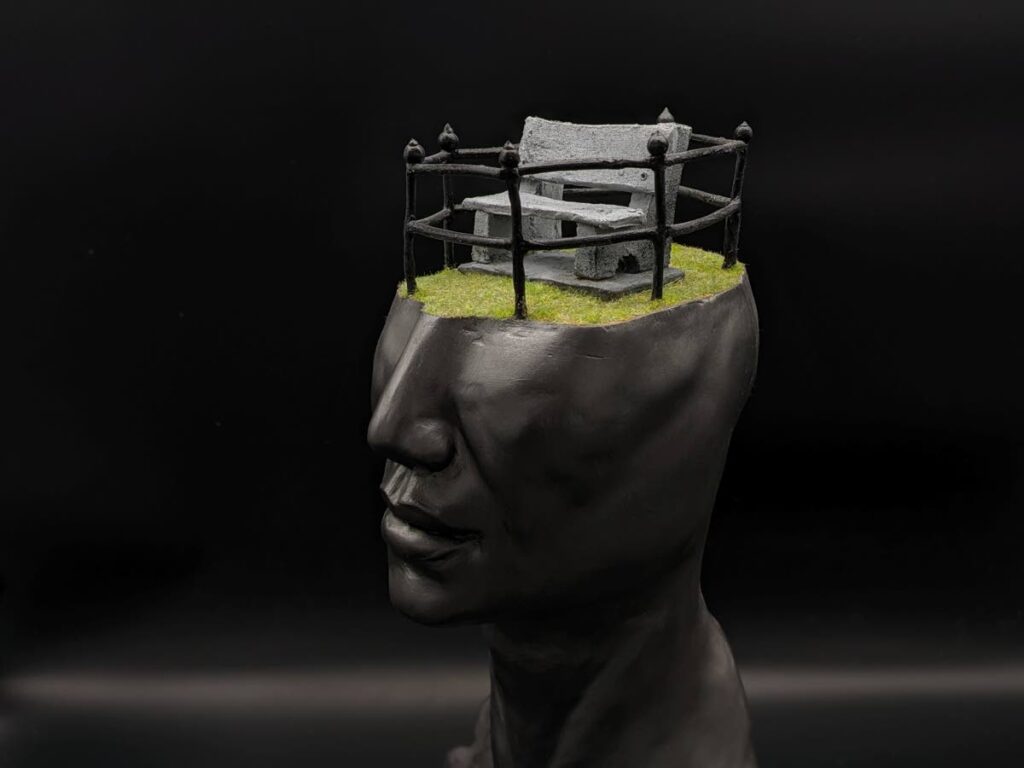Artists Sherlann Peters, Maria Diaz: Yoruba monument 'our biggest dream'

Artists Sherlann Peters and Maria Diaz could not help but shed tears of joy when, on June 18, one of their biggest dreams was realised with the unveiling of the Yoruba Village Monument.
Commissioned by the Emancipation Support Committee (ESC), the monument was unveiled at the Yoruba Village Square, east Port of Spain, during the Yoruba Village Drum Festival. It is a tribute to the Yoruba Village Community which has made significant contributions to the social, economic and cultural landscape of TT.
The sculptors said they dreamt of building a monument one day and leaving a permanent mark on national soil. It is even more meaningful to them because they understand what the sculpture means to the area and the country. It is also a great achievement for young female artists as most of the pieces in the capital were done by men.
“It was surreal to do the largest statue in east Port of Spain,” said Peters who designed the monument.

Made out of sculpting putty and painted with bronze oxidising paints and a patina, the monument is that of a Yoruba male and female, identified as such by the facial scarification.
Constructed by Diaz, 26, the female figure is a nurturing one. In her hands she holds a calabash bowl full of black-eyed peas with a plant sprouting from it, signifying new growth and the continuation of African culture and heritage. She is adorned in a gele (head wrap), cowrie shells and an anchor pendant around her neck. And since the national instrument came from what used to be know as Yoruba Village, the design of her collar is that of the steelpan while her earrings are steelpan sticks.
The male figure was constructed by 42-year-old Peters. He is dressed in African garb and hat (an aso oke agbada and abeti aja), and wears a sankofa pendant. The cola.siu.edu website translates “sankofa” as “go back to the past and bring forward that which is useful” while berea.edu translates it as “it is not taboo to fetch what is at risk of being left behind.”
He is also playing a talking drum and stick and Peters explained, “The talking drums were banned during slavery, but from that ban came the evolution of the steelpan. He is like the father protecting everyone and he’s bringing up the rear with the music and the rhythm. He represents the festival, the vibe of the area which is appropriate as we see the influence of African music of soca and calypso.”
Peters told WMN the ESC contacted local artist Kenwyn Crichlow about the project three years ago and he recommended her as she was one of his former students at UWI. Excited and ready to meet any challenge, she contacted Diaz, a fellow sculptor and friend of eight years to partner with her on the project.

And they are perfect partners as, although they both cover similar topics in their work, Peters’s style of art is realism while Diaz’s gravitates towards surrealism and contemporary art.
They immediately began working on research and design, the inner mechanism, how to install it, sourcing materials, and the sculpting process. But, due to challenges of increased costs and delays because of the pandemic, it was only a year ago that they began acquiring the materials and building the monument.
They thanked all who assisted them in making their dream come true including Rauf Aregbesola, then governor of Osun State Nigeria, who made the initial financial contribution in 2018, and later the East Port of Spain Development Company as well as the PoS City Corporation which made the base of the monument.
ART IS LIFE
Peters is a self-taught artist who has been painting and drawing for as long as she can remember. Her father does art as a hobby and her brother, Shawn Peters, is an artist of painting and sculpture.

“I’ve been doing art ever since I was young. It being in my family, I don’t think I could have escaped it and I didn’t want to because I love it.”
She recalled her grandmother sending her to the post office as a child. She would marvel at the pictures on the stamps and wish she could create such work. And she was able to reach that goal in 2004 when she did a stamp collection for TT Post commemorating the abolition of slavery.
Her love for art expanded exponentially while attending Morvant Laventille Secondary School. There, her art teacher introduced her to artist Makemba Kunle. She became inspired by his work and the work of other local artists like LeRoy Clarke, Bill Trotman, and Fitzroy Hoyte.
Then, at age 15, she sold her first piece – a drawing of two women in colourful Caribbean clothes sitting on a couch – at an art exhibition at Toco Secondary School.
“Through Studio66, I sold that piece to a German couple who were on vacation for $800. After that, I was an artist. That was it for me.”
She ignored the rest of her studies to focus on art. So much so that, during her CXC math exam, she drew everyone in the room and walked out. Since then she has been exhibiting at art galleries every year.
“Art was my main goal. I didn’t even think that I would need English, social studies or anything else to support my art. Of course I went back and did other subjects after.”
She later did a certificate course in visual arts and, several years later, the degree programme from which she graduated in 2017.
She was also part of the 2011 Women as Agents of Change Exhibition where she created a sculpture of Calypso Rose which was produced for the Commonwealth Day celebrations for the Queen.
Diaz was introduced to art when she started attending Bishop Anstey High School East where Peters taught art for a year.

“Although she was not my teacher, there was a day she brought in a sculpture and I happened to see it. At that time I already knew I wanted to do art. I was more focussed on digital arts and animation but I was still searching for what medium I would be selecting. That was the first interaction I had with realism, clay and sculpture, and I thought, ‘This is so amazing! I need to do sculpture.’
“Animation is a digital form of sculpting, using a computer programme to sculpt the pieces. So, for me, it goes hand-in-hand.”
During her A-Levels she studied under artist Elsa Clarke who nurtured and helped develop her skills. Still, she was set on pursuing animation and game design. She received a partial scholarship to a school in Canada but was unable to afford it. So she applied to UWI’s visual arts degree programme and turned her focus to fine art.
There, she met Peters and the women clicked instantly. They were also awarded Caricom scholarships to attend a year-long exchange programme at the University of Calgary in Canada where they lived and studied together and further developed their friendship.
She works at the Ministry of Sport and Community Development and had her first exhibit in 2019.
Over the years both women did work for Carifesta and for Central Bank, but the Yoruba monument is the first piece they ever worked on together, which they hope to do again.
They are looking forward to doing more monuments, possibly one of TT’s icons, Peters said. They hope to do a joint exhibition at some point in the future.

Comments
"Artists Sherlann Peters, Maria Diaz: Yoruba monument ‘our biggest dream’"